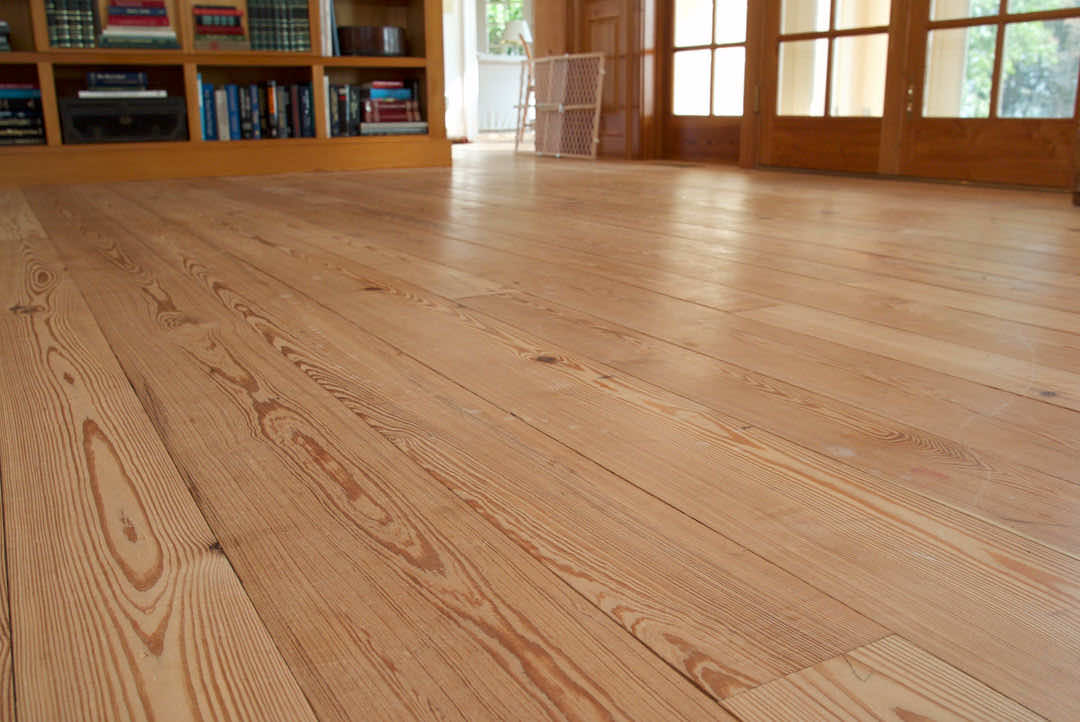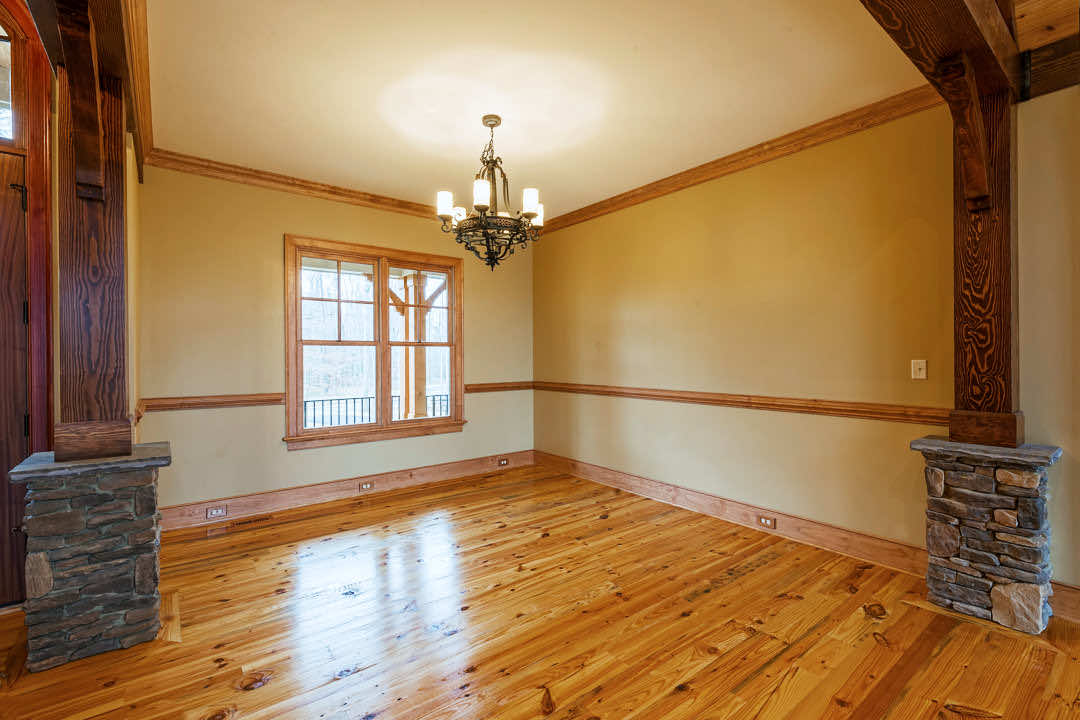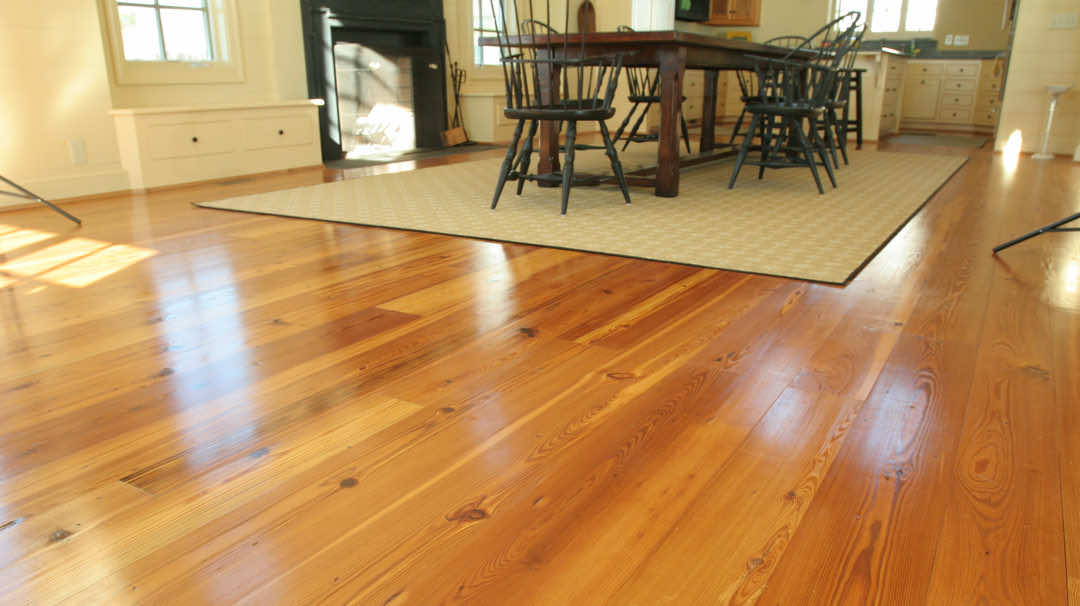Guide to Rustic Wide Plank Hardwood Flooring

“Rustic” wide-plank hardwood flooring instantly sets your renovation or upgrade apart with timeless beauty and old world charm. Choosing professionally reclaimed antique hardwoods adds lasting value and unmatched durability to your project and connects you to a long tradition of quality American craftsmanship.
Read on to learn more about the unique appeal and practical benefits of reclaimed hardwood flooring and how to find the ideal historic woods for your space.
Above Board: Rustic Wide Plank Hardwood Flooring
While hardwood has become increasingly popular for home flooring in recent years, the unmistakable quality of a professionally-laid wide plank antique hardwood floor still commands respect from anyone who appreciates fine construction and authentic design. And it’s not just easy on the eyes. For centuries, the long-grained wood from America’s slow-growing eastern forests has been appreciated for its unmatched strength, stability, and resistance to moisture. Plus, its natural flexibility makes it a durable, generous, and forgiving material to have underfoot.
Today, “rustic” wide plank floors that incorporate reclaimed ancient hardwoods are very desirable. Here we’ll take a look at what makes reclaimed vintage wide plank flooring so unique but also assess both the advantages and potential drawbacks of using reclaimed flooring in your renovation or construction project.
We’ll also list some important things to bear in mind when looking to source quality reclaimed wood for your own vintage wide plank hardwood floor.
What Is Wide Plank Flooring?
Technically speaking, wide plank flooring is any original wood plank product wider than the 2.5 to 4-inch solid or remanufactured wood board products commonly used for commercial “hardwood” floors. In practice, most buyers and suppliers consider true wide plank flooring to be original wooden planks that are at least six inches wide.
The actual width of the planks is often a good indication of the age of genuine hardwood flooring, as large trees became more scarce when the original old-growth forests along the eastern seaboard were logged.
At the same time, the trunks of even the oldest local eastern pine species favored for making floorboards seldom allowed planking wider than 12 inches to be cut.
What Makes Vintage Wood Floors Unique?
Hardwood flooring brings warmth and natural texture to any space, but genuine reclaimed woods add an unmistakable sense of character, depth, and connection that you will recognize every time you walk through the door.
Natural Qualities
Reclaimed woods are a window to the past. These sometimes rare woods feature unique natural colors and grain patterns that are seldom found in modern commercial lumber. Examples are the dark heartwood found in genuine old-growth heart pine, the long and straight grains of genuine reclaimed yellow pine, or the telltale tinge of true tidewater pine from the mid-Atlantic coast.
Unique Features
Reclaimed wood always comes with a human history. From the irregular textures of a hand-hewed surface to the distinctive swirls of early circular saw milling, every piece of reclaimed wood bears the imprint of the past.

Add to that the singular warping, wear, nail holes, and rust staining any hardworking piece of lumber must bear and you have a singular story right under your feet.
A Living Legacy
The best part about owning a reclaimed wood floor is that the story is not over. These woods might be all we have left of long-forgotten pre-colonial forests since they were once part of the factories, mills, warehouses, and barns of an earlier America. By making them part of our busy everyday lives today we honor that legacy by continuing it.
Pros of Reclaimed Wide Plank Flooring
While the beauty and historical legacy of quality reclaimed wood are easy to appreciate, there are many practical reasons for choosing it for wide plank flooring.
1. Durability
There was a reason our ancestors chose these woods and why their work is still with us today. These slow-growing first- and second-growth woods have a strength and durability you just won’t find in modern commercial softwoods.
2. Flexibility
At the same time, the size of these early trees gave boards sawn from them a unique flexibility that gives a well-constructed reclaimed wood floor a unique “sprung” quality.
3. Stability
More importantly, the tight grain of genuine antique hardwoods is remarkably stable, meaning the boards are more resistant to swelling, warping, or cracking as moisture levels change with the season and years. That means less creaking, gaping, and unevenness even after years of use.
4. Finishable…
Good-quality reclaimed wood can be finished in many ways using simple stains, durable varnishes, sealants, or (if you must) paint. Start with good materials and the results will speak for themselves.
5. … And Refinishable
Premium reclaimed wood flooring rewards careful renovation, from repeated staining and waxing to full sand-down renovations. Quality always shines through!
6. Fewer Planks, Fewer Seams
While wider floorboards will usually cost more, you won’t need to buy as many planks and you’ll have less pieces to nail down. It also means fewer seams, which will add to the visual appeal of your floor. This also makes it easier to clean and maintain plus minimizes potential trip hazards as the floor ages.
7. Sustainability
Reclaimed wood is a finite resource therefore good quality, legacy woods will cost more. At the same time, choosing to include it in your construction extends the life of a valuable product and keeps it out of landfills. It also helps reduce demand for modern commercial forestry products that are in many cases far more carbon-intensive and much less durable.
Cons of Reclaimed Wide Plank Flooring
Despite its obvious appeal, reclaimed wood is not ideal for every flooring project, especially if you have limited time or a tight budget.
1. Cost
High-quality, responsibly reclaimed wood simply costs more. Reclaiming, cleaning, and grading this lumber is very labor-intensive. Premium reclaimed wood will cost you more up front but will pay off over time. That said, skimping on quality with cheaper wood can mean expensive do-overs, repairs, and maintenance work for years to come.
2. Availability
There’s only so much good-quality reclaimable wood out there so it can be harder to find the exact quality and size of lumber you need.
For best results work with an established, reputable wood reclamation company like E.T. Moore. We have the widest selection of quality reclaimed lumber on hand as well as the knowledge, experience, and connections to source specialty orders.
3. Inconsistent Size
Along with limited availability comes inconsistent sizing. Not only were older boards not cut to the same exacting standards as modern lumber products, but job lots tend to include pieces of many different sizes. At E.T. Moore, we’re known for our consistent grading and we have the milling and finishing equipment to bring your order to specification if necessary.
4. Inconsistent Quality
Reclaimed wood comes with a personality of its own. That’s why we love it—but warping, bending, and staining as a result of historic use is part of the challenge and charm of working with a legacy product. At E.T. Moore we work hard to keep quality and character consistent, but if absolute uniformity is important then reclaimed wood is probably not for you.
5. Maintenance
Reclaimed wood is a responsibility. Keeping antique woods in use means taking care of them with regular cleaning, maintenance, and sometimes refinishing. If you’re not ready for a long-term commitment, then you might be better off with a low-cost, low-maintenance softwood or a manufactured wood product.
Own the Room: Buying Reclaimed Wood Flooring
If you’re serious about making reclaimed wood flooring part of your life then it’s worth taking the time to make smart choices that will deliver value over the long term. Here are some important things to consider:
Choose Quality
Not all reclaimed wood is the same. While lightweight, reclaimed barn wood is popular for decorative use, this is rarely suitable as flooring. If you’re in it for the long haul, genuine reclaimed pine, hemlock, cypress, and spruce are good choices. That said, the tried-and-true durability, stability, and visual appeal of genuine reclaimed heart pine are hard to beat.
How Wide Is Wide Plank?

The wider the planks you choose for your wide plank floor, the more you will pay. At the same time, reducing the number of seams in your floor and the nails and substructure needed will yield some savings. Remember also that wider usually also means longer. Choose longer length boards the wider you go to maintain a sense of visual harmony and proportion in your floor.
Consider Mixed Width
You can keep costs down by opting for a mixed-width floor that intersperses wider and narrower floorboards. Be sure to choose wood that has a very similar grain to avoid a “striped” effect. For best results, work with a professional installer.
Go With the Grain
Also, think about the overall visual effect of the grain in your floorboards. For consistency, choose the long, straight, combed grain of yellow pine. For interest, however, you may prefer the elegant cathedral-arch lines of heart pine. Consider how these lines will work with the width and length of your boards, particularly in narrow or elongated spaces like hallways or bathrooms.
Moisture Control
A critical factor in any original wood flooring is the amount of moisture in the wood you are buying and installing. Moisture content should ideally be very low but also needs to be consistent throughout the job lot you purchase to prevent shrinking, swelling, or warping as your floor is installed.
Be sure to work with a supplier who knows how to handle and store wood correctly. At E.T. Moore, we kiln dry reclaimed wood to ensure consistency and store all of our inventory indoors.
Grade Points
Reputable suppliers like E.T. Moore grade all the wood we handle according to the number of board faces that meet a particular standard. The more matching faces that wood in a lot has, the higher the grade assigned.
Raw reclaimed wood lots vary in quality and the size of individual planks or boards, meaning more pieces in a lot will be considered “out of grade.” The more “in grade” a lot is, the more of the original reclaimed wood will have to be discarded or milled. Lots are also graded according to color, grain, knotting, rust staining, and nail holes.
Professional grading helps to protect buyers. The knowledgeable staff at E.T. Moore will be glad to explain how our grading affects quality, consistency, and price.
Matchmaker
If you are undertaking a repair or restoration work or adding an extension on an older building you may have to find planking that matches existing floorboards. As one of the largest wood reclaimers on the East Coast, E.T. Moore has more than 50 years of experience in identifying, matching, and sourcing the rare antique hardwoods used in historic construction.
E.T. Moore: Your Quality Reclaimed Wood Source
Reclaimed wood is not always what it seems to be. To ensure you get the lasting quality and appeal you are paying for, work with a reputable partner.
At E.T. Moore, we’re working hard to put quality historic hardwoods into homes and workspaces where they will be used, preserved, and cherished for generations to come. We specialize in turn-of-the-century reclaimed heart pine flooring and other high-quality antique hardwood products. We offer:
- A wide selection of quality off-the-shelf reclaimed wood floorings
- Custom matching from our unrivaled on-site stock of reclaimed lumber
- Custom milling and molding services
- Decades of experience in sourcing and grading the best reclaimed woods
Talk to us about your reclaimed hardwood flooring needs. We’ll provide grading advice, expert millwork, and we can usually source special orders within two weeks. Contact us today or click below to learn about our reclaimed wood flooring products.
Reclaimed Wood Flooring